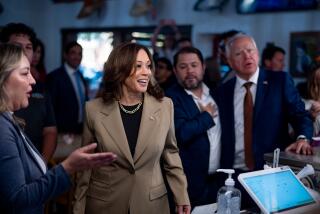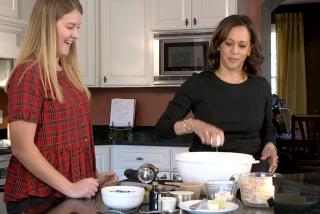Must Reads: Why you can’t look away from that Trump fast food photo
President Trump served the college football national champion Clemson Tigers a fast food buffet for their official White House visit Monday, and newly released photos from the event are pretty incredible to many people, including a UCLA art history professor who saw parallels to Leonardo da Vinci’s “The Last Supper.”
The White House staff who would ordinarily cook and serve the meal were tied up with the government shutdown, the explanation went, and so the president paid out of pocket for a selection from McDonald’s, Wendy’s and Burger King.
Pictures taken by official White House photographer Shealah Craighead were posted on the verified @WhiteHouse Twitter account. One in particular stood out.
The tweets came fast and furious, marveling at what some may see as a metaphor for Trump’s tenure: The president, arms spread, in the formal State Dining Room of the White House, with a feast of boxed fast food stacked neatly on silver trays between gold candelabra. George P.A. Healy’s 1869 oil painting “Abraham Lincoln” painting looks on from above.
It’s quite an interplay: opulence and modesty, high and low, point and counterpoint, Trump in the middle. It evoked a period costume romp about royals or some dark comedy on cable. For some, it was hard to look away.
For others, it elicited comparisons to contemporary art, of a kind.
It is not surprising that people found the photo visually arresting, said George Baker, a professor of art history at UCLA who specializes in modern and contemporary art. It observes the rule of thirds and has some aspects of the golden ratio, he said, but it’s more powerful in the way it evokes classical art.
“You think of all of the great images of feasts in the history of art,” Baker said. “Right away, the most famous images are religious — ‘The Last Supper’ with Christ. And you have this incredible gesture [he’s] making, but it’s not really a presentation of the bounty and the food. He’s holding his hands up in a Christ gesture that we associate more with the crucifixion.”
It’s a gesture, Baker said, that calls to mind executions and political protest paintings. “The Third of May 1808” by Francisco Goya and “The Execution of Emperor Maximilian” by Edouard Manet feature similar positions.
The subject matter is also evocative. Baker pointed to “The Land of Cockaigne” by Pieter Bruegel the Elder. It depicts a feast taking place in “a medieval land of plenty, which is appropriate as an allegory” for the White House event, Baker said. In it, the food prepares itself: A goose lays down on a plate, an egg walks on two legs with a knife in its cracked shell, a pig carves a strip of bacon from its side.
For Baker, though, the most interesting thing about the photography is the interplay between Trump and Lincoln. Healy’s “Abraham Lincoln” was completed before Rodin’s “The Thinker” sculpture, though the pose is the same and has been used throughout art history to depict contemplation, including in Michelangelo’s tomb for the Medici princes.
“The gesture Trump is making could be no more different,” Baker said. It’s “so striking and so the opposite of the contemplative figure behind him, and the lineage of thought that that painting borrows from.”
On Twitter, people got tired of the photo quickly. “How do I mute a photo” could well be 2019’s “Twitter needs an edit button.” But the photo’s resonance shows that even in an age where Big Macs substitute for a state dinner, people can still find parallels to fine art where they least expect it.
Follow me on Twitter @jessica_roy.
More to Read
The biggest entertainment stories
Get our big stories about Hollywood, film, television, music, arts, culture and more right in your inbox as soon as they publish.
You may occasionally receive promotional content from the Los Angeles Times.











